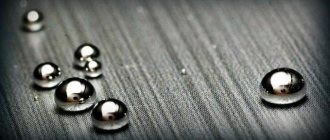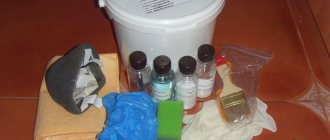And everyone knows that mercury vapor is very dangerous to human health, even if it’s just a broken thermometer. That is why you need to know all the rules of behavior in case of damage to a mercury thermometer.
After reading this article, you will find out how much mercury is in the thermometer and how long it takes to evaporate - is it dangerous to collect mercury and many other details will soon be known to you.
Properties of mercury
Mercury is a metal that is listed as element 80 in the periodic table. Being a cumulative poison, it belongs to hazard class I. This is the only metal that does not turn into a solid state at room temperature, remaining in liquid form. The release of toxic substances begins when the temperature rises to +18 ° C, and since mercury takes a long time to evaporate, this makes it especially dangerous.
An ordinary thermometer contains from 1.5 to 2 g of liquid metal - this amount is very large, and if it evaporates completely in a closed living space, the area of which does not exceed 20 m2, the concentration of toxic vapors will exceed the permissible limit of 0.0003 mg per 1 m3.
What is important to do after removing mercury
After eliminating mercury, you need to do an air analysis. This is done with special devices, which are equipped by specialists from special companies who are professionally involved in the collection, transportation, placement and other activities and work with substances of various hazard classes. An air analyzer allows you to examine the room meter by meter and make sure that the danger has passed after eliminating the toxic substance. In this case, the device will show the absence or slight excess of the established standards.
Mercury evaporation rate
In one hour, 0.002 mg of mercury evaporates per square meter. Thus, it is easy to calculate the rate of its evaporation in a living room at room temperature by multiplying this indicator by the total area (90 cm2) of scattered balls: 0.002 x 90/10000 = 0.000018 mg/hour.
But at the same time, the speed of this process will always be influenced by certain factors: temperature fluctuations, quality of air circulation, surface area of scattered particles and the total amount of toxic substance. After all, it is not always possible to collect all the mercury. Some of it may roll under baseboards, into cracks and small chips in floors.
One small ball of mercury from a broken thermometer takes a long time to evaporate - at least 3 years. If the house has warm floors and rare ventilation, then this period will noticeably decrease, and, conversely, increase with constant ventilation.
You can also roughly determine how long it takes for 2 grams of mercury to evaporate in a normally ventilated living space. Having made simple calculations, we get a period of 30 years. But remember that everything is conditional.
If we talk about how long it takes for mercury to evaporate outdoors, then this period will also depend on environmental conditions. It is known that under the influence of direct sunlight and air temperatures from +35 ˚С to +40 ˚С, the evaporation rate increases by 15-17 times. In the cold season, it correspondingly decreases.
And don’t forget that over time, the rate of mercury evaporation drops - after a couple of weeks it approximately doubles, and so on.
What is a thermometer?
One of the frequently asked questions is, quote, “how much mercury is in a thermometer?”
The thermometer that we are all so used to using at home contains approximately 1 to 3 grams, all this depends solely on the country that produces mercury thermometers. So, our domestic thermometers may contain 3 grams of mercury, but for example, a thermometer that was made in the Netherlands contains only one gram of mercury. It is difficult to measure the weight of the mercury itself in a thermometer, so when purchasing, you can check the country of the thermometer manufacturer in order to protect yourself to some extent in the future. It is worth noting that 2 grams of mercury when evaporated can poison up to 10 people with serious consequences. Therefore, we can conclude that there is enough mercury in the thermometer to poison everyone who will be in a closed room while the thermometer is broken.
How dangerous is mercury?
So, we found out how long it takes for mercury to evaporate in a room and at what speed this process occurs, from which it follows that 0.18 mg of toxic vapor is released in one hour. Comparing this indicator with the maximum permissible concentration (0.0003 mg/m3), we see a rather strong excess. But this still doesn’t say anything. The fact is that the maximum permissible concentration is calculated taking into account the initial criteria - the threshold concentration for a long time - from six months to a year, and plus a guarantee amendment is applied, which reduces this value several times.
There is another value, which is defined as the weekly dose of mercury for a person. It is 5 mg per 1 kg of weight. Thus, it is easy to calculate the maximum permissible dose for each family member. And taking into account the volume of air consumed by a person (25 m3 per day), we can calculate the maximum permissible dose. To do this, we multiply this value by the permissible level of mercury vapor (0.0003). We get 0.0075 mg per day. We calculate the weekly dose by multiplying the result by 7.
And in order to understand how dangerous mercury from a broken thermometer is, you should determine the volume of air in the room that absorbs the fumes. You can make calculations by multiplying the length of the room by the width and height of the ceilings. In general, it’s worth immediately finding out the volume of air in the entire apartment. This is due to the fact that the vapors of this substance are volatile, and since mercury in the room takes a long time to evaporate, they will certainly spread throughout all rooms. So, with a total area of 60 m2 and a ceiling height of 2.7 m, we obtain a volume of 160 m3. We remember that the air is not static; with normal ventilation, 80% of the obtained indicator is replaced in one hour. Thus, circulation automatically increases the volume of air that consumes mercury vapor to 300 m3.
Now you can calculate the mercury concentration. To do this, divide the amount of evaporation (0.18) by the volume (300). The result is 0.006 mg per 1 m3. We compare it with the acceptable level (0.0003) and understand that not everything is as bad as it might seem at first glance. We have a double dose, which is not critical. However, it should not go unnoticed.
Thus, knowing in what quantity and for how long mercury evaporates and disappears, you can easily determine its potential harm for a particular room and the people living in it.
Precautionary measures
It must be remembered that when collecting mercury, it is imperative to protect your hands with rubber gloves. You should put bags or shoe covers on your feet so as not to spread metal around the apartment. It is imperative to put a gauze bandage on your face, which should first be soaked in a soda solution.
Then you need to prepare some kind of container with a lid to collect the mercury there. You must first pour a manganese solution into this container. Also, to collect mercury, you need a medical bulb with a thin tip, or a syringe without a needle. If you don’t have any of this at home, then plain paper and cotton wool will do.
If the thermometer was broken in a room where there are many cracks in the floor, then you should use a flashlight to look at everything very carefully. If a thermometer breaks on the carpet, you should not vacuum it under any circumstances. It is strictly prohibited to use it when collecting mercury. To collect mercury from a carpet, you need to take it outside. You need to lay a film under the crossbar, and then hang a carpet on it and knock it out.
After collecting the mercury, you need to wash the floor with a solution of potassium permanganate. After this, you should wash the floor again with a solution of soda and soap. This will neutralize any remaining mercury particles that you may not have noticed.
In addition to the above options, you can also collect mercury with a magnet. To do this, you need to wear thick rubber gloves and collect the mercury with a magnet, then carefully remove the gloves. After such treatment, you need to wash all the clothes in which you did this. You also need to rinse your mouth with a soda solution, wash your hands and wash your face.
REFERENCE! It is strictly forbidden to throw mercury into the sewer or garbage disposal. It is best to conduct a chemical analysis of the air in the room after collecting mercury.
Symptoms of poisoning
Mercury from one broken thermometer will not cause irreversible changes in the functioning of organs, paralysis or death. But still, the body is able to respond to harmful fumes with general weakness, loss of appetite, headaches, nausea, metallic taste in the mouth and vomiting. And if such symptoms are observed, then the victim must urgently receive medical assistance. In addition, since mercury from a thermometer takes a long time to evaporate, it will continue its effect on the body of a weakened person. And this, in turn, will worsen the signs of poisoning, which will lead to bleeding gums, abdominal cramps, a sharp increase in body temperature and loose stools with blood and mucus. This condition requires urgent hospitalization.
Information about how long it takes for mercury to evaporate and why it is dangerous is especially important for parents and women during pregnancy. The main risk group is children, who may develop kidney problems after short-term inhalation. Pregnant women should also beware - there is a risk of intrauterine damage to the fetus.
A thermometer broke in a house or apartment: is it dangerous and why is there any reason to worry?
Photo from the site: postirke.ru
To begin with, you should definitely understand that all devices of this kind, such as a thermometer, must have their place in the apartment, where the omnipresent little hands of your baby cannot reach, or where the sneaky cat, who strives to get into the most inaccessible corners of the apartment's bowels, cannot get into. . But it happens that due to careless handling, a thermometer or mercury thermometer breaks, and a silvery liquid flows out from a thin tube, collecting in balls. This is mercury, a metal that is toxic and dangerous to the human body. True, to be completely honest, it is not mercury that poses the danger, but its fumes and the consequences of a broken thermometer can be fatal if measures are not taken in time.
The dangers of a broken mercury thermometer
For humans, mercury itself is not dangerous, since it can enter the body only through ingestion, and only a small child left unattended can eat this metal. It is the fumes that are toxic that begin to poison the atmosphere of your home already at a temperature of 18°C. Mercury toxins in the body tend to accumulate, gradually aggravating the condition of the affected person, that is, they have a cumulative effect. Moreover, if you do not carry out the entire complex of cleaning the room immediately, then later you will be able to observe real mercury intoxication.
That is, if you or other people break a thermometer in an apartment, you should think about what to do in advance, and not let everything take its course, otherwise at one point it may simply be too late, and treatment for the consequences simply will not give any results. As soon as the thermometer breaks, the mercury breaks up into balls of different sizes, and the smallest of them are not at all easy to notice, especially if there is a carpet on the floor, or there are gaps between the boards, or the tiles are laid unevenly, and the seams between the tiles are not sealed flush. Within a few months, a person may begin to experience mercury intoxication, which is expressed in a number of symptoms. However, the most dangerous thing is when exposure to vapor occurs in small doses, but over several years.
- Fatigue, significantly increased drowsiness, and frequent headaches.
- Frequent dizziness, general weakness and reluctance to do anything, causeless apathy towards everything.
- Changes in character, in the form of excessive irritability, attacks of aggression, or, conversely, shyness or shyness.
- Significant deterioration in receptor reactions, trembling in the arms and legs, inability to concentrate on a specific object.
- A significant decrease in pressure to abnormal levels, frequent urination, disturbances in the functioning of the thyroid gland, as well as the heart.
Photo from the site: otravlenie03.ru
This means that if you break a thermometer at home, you need to think about what to do right away, and you definitely shouldn’t hope that everything will go away on its own. After all, mercury vapor poisoning can lead to tuberculosis, atherosclerosis, gall and liver diseases, and even hypertension can last for the rest of your life. That is, if a thermometer with mercury is broken, you will have to decide quickly what to do, and act even faster. But first, it’s worth understanding what absolutely cannot be done in such cases.
How to collect mercury?
Understanding how long it takes for mercury to evaporate and what consequences this brings, everyone should be able to collect it. First you need to lower the air temperature in the room by turning off all heating devices. If it’s cold outside, you can open a window, but only one, so that the draft does not break the scattered balls into smaller particles. In summer it is advisable to turn on the air conditioning. These measures will stop the process of evaporation of toxic metal.
Directly for the cleaning itself, you will need thin copper wire, metal filings or powder, a sheet of sandpaper, a sheet of plain paper and a hermetically sealed jar.
Prevalence in nature
In the earth's crust, the concentration of the chemical element is low. Mercury ore minerals contain up to 2.5% living silver. This sets them apart from other breeds. Most mercury is found in dispersed form, and only some is found in deposits.
In igneous rocks, the fractional content of living silver is equal to each other, and in sedimentary strata, large concentrations of the metal are concentrated in clay minerals. The waters of the World Ocean contain 0.1 µg/l of mercury.
A high degree of ionization determines the characteristics of the metal:
- to be restored to the state of a native element;
- resistance to acidic environment and oxygen.
The chemical element is present in sulfide minerals (sphalerite, realgar). This metal is an indicator of mercury deposits and hidden ore bodies. Under surface conditions, living silver and cinnabar do not dissolve in water, but in the presence of sulfuric acid and ozone it helps to increase the solubility of minerals.
Mercury has excellent sorption properties. In nature, there are about 20 minerals containing this metal, but industrial extraction is carried out in cinnabar deposits.
One of the largest deposits is located in Spain. The metal production technology involves firing cinnabar, followed by condensation and collection of mercury vapor.
Removing mercury using copper wire
Since mercury evaporates for a long time, and at high air temperatures it also evaporates intensely, before you start cleaning, it is advisable to protect the respiratory tract with a gauze bandage.
Then we take the wire and wind it so that we get a rope about 1.5 cm wide and 15 cm long. To prevent it from falling apart during the cleaning process, we tie it in the middle with thread or a small piece of the wire itself. We cut off the ends on both sides so that they look like brushes. Using sandpaper, remove all the varnish and bend the bundle in half. As a result, both ends should be on the same side.
We make several turns of tape around the loop. This will make it much more convenient for you to hold the resulting brush in your hand. Then use your fingers to slightly open the cleaned area and bring it to the mercury balls. The copper will begin to amalgamate the metal particles, and soon they will all end up at its ends. Upon completion of the procedure, you need to put everything in a jar (along with the wire) and close the lid tightly.
How to use metal filings for cleaning?
To do this, they should be scattered on the infected area and thoroughly rubbed into the surface with a dry cloth. As a result, all the scattered particles of mercury will appear on it. We place them in a jar along with sawdust and seal it tightly.
This method of cleaning mercury is quite simple, but it is only suitable for smooth surfaces, for example, linoleum, plastic, marble, etc. For surfaces with cracks and grooves, a different method should be chosen.
Mercury on shag carpet
It is important to carry out thorough cleaning here, since mercury from a broken thermometer takes a long time to evaporate. If it is not all collected, toxic substances will continue to be released, gradually accumulating in the human body. At the same time, the symptoms of poisoning are not noticeable at first, but the consequences can be felt after a few weeks. And this, in turn, will make diagnosis very difficult.
It is most difficult to collect all the mercury from soft surfaces, especially if they have long piles. But you need to try, otherwise the carpet will simply have to be thrown away.
We pour metal filings in the place where the thermometer broke and roll up the carpet to this area. We wrap the area with mercury in polyethylene, carefully knock it out and leave it to ventilate. Place the fallen mercury balls together with the film into a jar and close it well.
How to protect yourself from poisoning?
The last step is to cleanse yourself. Throw away shoe covers, take off clothes. Washing items that have come into contact with mercury can contaminate your washing machine, bathtub, or sink. Therefore, it is recommended to put all used rags and clothes in a sealed bag and take them along with the can for disposal.
The Ministry of Emergency Situations recommends that after such incidents, for prevention, gargle with a weak solution of potassium permanganate, brush your teeth, and drink activated charcoal. But, fortunately, if you break just one thermometer, it is almost impossible to get poisoned by mercury. Theoretically, of course, you can get chronic poisoning if you don’t collect mercury at all. But this will take a lot of time.
If you're still worried, to reassure yourself, you can get your blood and urine tested to see how much mercury is in there. It is also worth monitoring your well-being. Mercury vapor affects the central nervous system. The primary signs of mercury poisoning are fatigue, drowsiness, weakness, migraines, dizziness, apathy, irritability, depression, memory impairment and attention. Judging by these signs, each of us has a kilogram puddle of mercury lying somewhere in our apartment... Just kidding!
What did I personally do when a mercury thermometer broke in my home? I have laminate flooring and no carpet in my home, so collecting the mercury was easy. I collected most of it with a piece of paper and placed it in a jar of water, and collected small drops with a brush. Then I gave everything to the Emergency Situations Ministry brigade. They really didn’t want to accept, but I convinced them.
How naive humanity became acquainted with radiation
7 long-term experiments
What should you not do with mercury?
Sweeping mercury with a broom, especially from the carpet, is strictly prohibited. This way you will only break up the particles of the substance, expanding the volume of evaporation. You should also not vacuum the contaminated area, otherwise a warm motor will increase the rate of evaporation, and the vacuum cleaner itself will subsequently have to be thrown away.
If mercury balls get on things, they should be destroyed. Machine washing is prohibited, as it will not save clothes - they will become dangerous in the future.
It is not allowed to flush the collected substance down the sink or toilet, as it is heavy and will most likely remain in the water pipe. How long does it take for mercury to evaporate under such conditions? Both long and intense. Thus, you will be constantly exposed to toxic fumes.
Even if a jar containing particles of toxic metal has been carefully sealed, you should not throw it into a trash container or garbage disposal. Sooner or later it will break and other people will be in danger.
What if the thermometer was broken by a child?
Of course, in a house where there are small children, it is better to use an electronic thermometer, but if you use a mercury thermometer and the child accidentally breaks it, then:
- it is necessary to carefully examine the child’s hair and hands; if there are balls there, they urgently need to be eliminated;
- when swallowing mercury, it is important to call an ambulance, and at home try to induce a gag reflex in the baby;
- if the child has swallowed fragments, then in this case nothing can be done until the ambulance appears; he must be laid on the bed and all his actions must be minimized;
- but it is important to change clothes that have been exposed to mercury immediately;
- if mercury does not come into contact with the baby, then he must be taken out of the room into fresh air and given activated carbon;
- carefully inspect the room and remove all fragments and balls from the thermometer;
- Try to drink plenty of fluids with your child for several days.
Attention! Parents should not particularly panic if a child swallows a ball of mercury, because this metal is almost not absorbed in liquid form, but passes through the digestive system.
The main thing is that the baby does not damage the intestines with fragments of the thermometer, and therefore a doctor’s examination in this case is absolutely necessary. To avoid such consequences, it is important to carefully treat such a medical item and store it in a separate place, out of the reach of children.
Where is mercury disposed of?
In general, if the mercury is on a flat, smooth surface or on a lint-free surface, then collecting it will not be difficult. In addition to the above methods, you can use a sheet of plain paper. But what to do next with this jar if you can’t throw it away? Special organizations can help in this matter, such as:
- sanitary-epidemiological service;
- management of the Ministry of Emergency Situations;
- mercury recycling service.
You need to call one of them and take the jar with the collected mercury to the specified address. Just be sure to ensure that it was carefully packaged. By the way, it is also advisable to recycle the clothes and shoes you wore for cleaning. For this reason, mercury collection is carried out wearing gloves and a special suit.
Who can help
The first thing to do if a thermometer breaks in your home is to call the Ministry of Emergency Situations. Until they come to you, you must independently identify and collect all mercury particles that come into contact with the air.
All mercury must be detected because even the smallest particles can cause big problems.
If it was not possible to collect mercury
When a thermometer breaks, mercury particles often fly quite far. They can get on upholstered furniture, in places where clothes and other things are stored, roll under the baseboard or end up in floor crevices. In such a situation, it is very difficult to collect every last drop. And only specialists can help here. Before the brigade arrives, you need to remove all people and pets from the contaminated room and open the window.
Upon arrival, special services workers will determine the level of mercury vapor concentration, conduct a thorough cleaning and identify items that will need to be disposed of.
How to finally clean the room?
If a thermometer breaks in an apartment, you need to treat surfaces in contact with metal with a solution of potassium permanganate or chlorine bleach. It is better to carry out the procedure daily for two weeks. It is necessary to ventilate the room two or three times a week; if possible, leave the window (window) open around the clock.
Containers with metal and things in contact with mercury must be hermetically sealed in polyethylene (plastic, glass) and taken to the SES.
It is recommended to invite specialists to measure the concentration of mercury vapor in the apartment.











